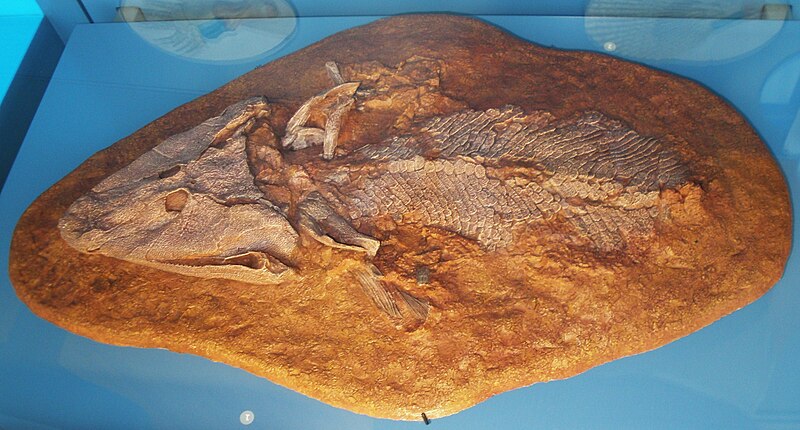[Recent Entries][Archive][Friends][User Info]
| September 28th, 2011 | ||||||||||||||||||||
|---|---|---|---|---|---|---|---|---|---|---|---|---|---|---|---|---|---|---|---|---|
| 08:00 pm [industrialterro] [Link] |
Tiktaalik Тиктаалик (Tiktaalik) — род ископаемых лопастепёрых рыб из позднего девона, имевших много общих черт с четвероногими. Название происходит от слова «налим» на языке инуктитут. Ископаемые останки были обнаружены в 2004 году на острове Элсмир (терр. Нунавут, север Канады). Тиктаалик является переходным звеном между рыбами и наземными позвоночными. В его строении сочетаются черты и тех, и других. Признаки, свойственные рыбам: Признаки с промежуточным состоянием:
Признаки, традиционно приписываемые четвероногим:
Tiktaalik lived approximately 375 million years ago. Paleontologists suggest that it is representative of the transition between non-tetrapod vertebrates ("fish") such as Panderichthys, known from fossils 380 million years old, and early tetrapods such as Acanthostega and Ichthyostega, known from fossils about 365 million years old. Its mixture of primitive "fish" and derived tetrapod characteristics led one of its discoverers, Neil Shubin, to characterize Tiktaalik as a "fishapod". The name Tiktaalik is an Inuktitut word meaning "burbot", a freshwater fish related to true cod. The "fishapod" genus received this name after a suggestion by Inuit elders of Canada's Nunavut Territory, where the fossil was discovered. The specific name roseae cryptically honours an anonymous donor. Tetrapod footprints found in Poland and reported in Nature in January 2010 were "securely dated" at 10 million years older than the oldest known elpistostegids (of which Tiktaalik is an example) implying that animals like Tiktaalik were "late-surviving relics" possessing features that actually evolved around 400 million years ago. Tiktaalik provides insights on the features of the extinct closest relatives of the tetrapods. Unlike many previous, more fishlike transitional fossils, Tiktaalik's "fins" have basic wrist bones and simple rays reminiscent of fingers. The homology of these is uncertain; there have been suggestions that they are homologous to digits, although this is incompatible with the digital arch developmental model because digits are supposed to be postaxial structures, and only three of the (reconstructed) eight rays of Tiktaalik are post-axial. They may have been weight bearing. Close examination of the joints show that although they probably were not used to walk, they were more than likely used to prop up the creature’s body, push up fashion. The bones of the fore fins show large muscle facets, suggesting that the fin was both muscular and had the ability to flex like a wrist joint. These wrist-like features would have helped anchor the creature to the bottom in fast moving current. Also notable are the spiracles on the top of the head, which suggest the creature had primitive lungs as well as gills. This would have been useful in shallow water, where higher water temperature would lower oxygen content. This development may have led to the evolution of a more robust ribcage, a key evolutionary trait of land living creatures. The more robust ribcage of Tiktaalik would have helped support the animal’s body any time it ventured outside a fully aquatic habitat. Tiktaalik also lacked a characteristic that most fishes have—bony plates in the gill area that restrict lateral head movement. This makes Tiktaalik the earliest known fish to have a neck, with the pectoral girdle separate from the skull. This would give the creature more freedom in hunting prey either on land or in the shallows Tiktaalik generally had the characteristics of a lobe-finned fish, but with front fins featuring arm-like skeletal structures more akin to a crocodile, including a shoulder, elbow, and wrist. The fossil discovered in 2004 did not include the rear fins and tail. It had rows of sharp teeth of a predator fish, and its neck was able to move independently of its body, which is not possible in other fish. The animal also had a flat skull resembling a crocodile's; eyes on top of its head, suggesting it spent a lot of time looking up; a neck and ribs similar to those of tetrapods, with the latter being used to support its body and aid in breathing via lungs; well developed jaws suitable for catching prey; and a small gill slit called a spiracle that, in more derived animals, became an ear. The fossils were found in the "Fram Formation", deposits of meandering stream systems near the Devonian equator, suggesting a benthic animal that lived on the bottom of shallow waters and perhaps even out of the water for short periods, with a skeleton indicating that it could support its body under the force of gravity whether in very shallow water or on land. At that period, for the first time, deciduous plants were flourishing and annually shedding leaves into the water, attracting small prey into warm oxygen-poor shallows that were difficult for larger fish to swim in. The discoverers said that in all likelihood, Tiktaalik flexed its proto-limbs primarily on the floor of streams and may have pulled itself onto the shore for brief periods. Neil Shubin and Ted Daeschler, the leaders of the team, have been searching Ellesmere Island for fossils since 1999.
Ископаемые останки (1, 2, 3, 4, 5):
Tags: Вымершие рыбы, Девон, Лопастепёрые | |||||||||||||||||||
| Comments | ||||||||||||||||||||
Крутой чувак, однако. Наш предок! (Reply to this) (Thread)
Во-во, однако, прикольно было бы произвести среди креациониздов опрос, на что больше похож тиктаалик - на рыбу или на земноводное. Это к вопросу "о переходных формах", естественно. (Reply to this) (Parent) | ||||||||||||||||||||









